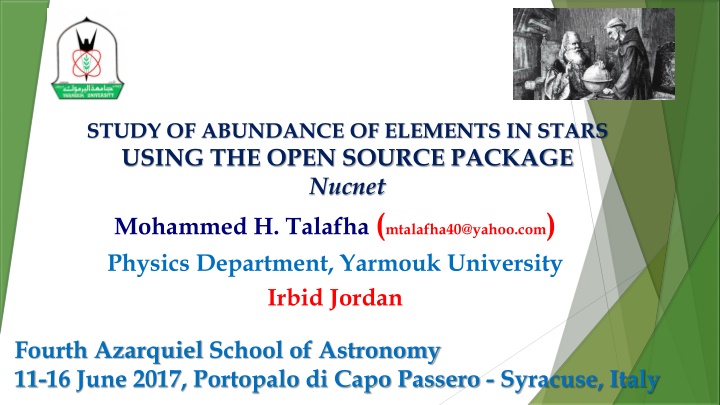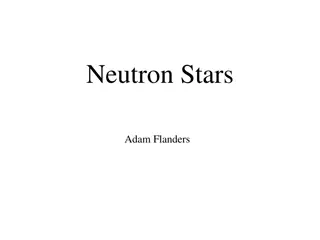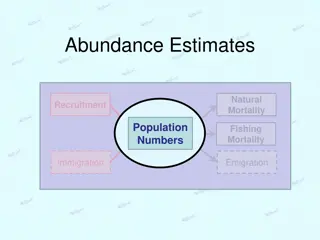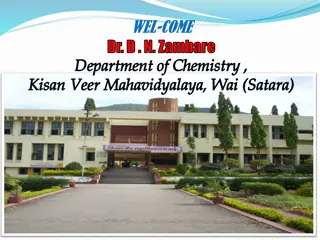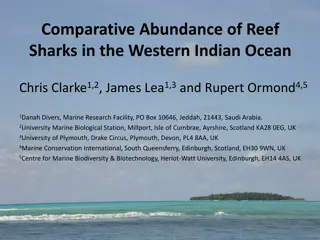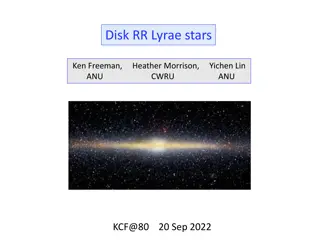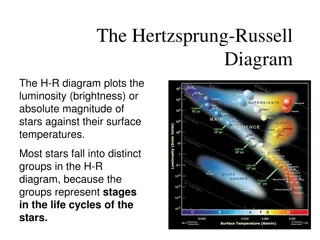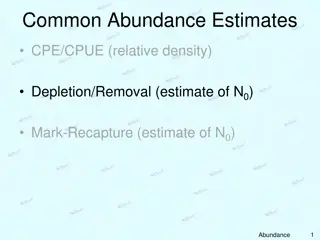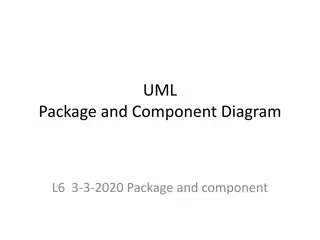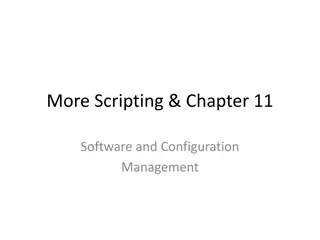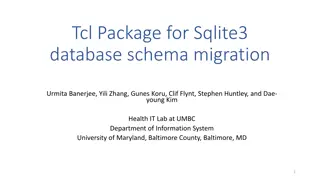Study of Abundance of Elements in Stars Using Nucnet Package
In this study conducted by Mohammed H. Talafha, the abundance of elements in stars is explored using the open-source package Nucnet. The research delves into various aspects such as sun evolution, oxygen production, computational analysis, and results obtained. Detailed observations on the evolution of stars, hydrogen and helium burning phases, metallicity, and chemical element abundances in the Sun are discussed. The findings shed light on the intricate processes governing the abundance of elements in celestial bodies.
Download Presentation

Please find below an Image/Link to download the presentation.
The content on the website is provided AS IS for your information and personal use only. It may not be sold, licensed, or shared on other websites without obtaining consent from the author.If you encounter any issues during the download, it is possible that the publisher has removed the file from their server.
You are allowed to download the files provided on this website for personal or commercial use, subject to the condition that they are used lawfully. All files are the property of their respective owners.
The content on the website is provided AS IS for your information and personal use only. It may not be sold, licensed, or shared on other websites without obtaining consent from the author.
E N D
Presentation Transcript
STUDY OF ABUNDANCE OF ELEMENTS IN STARS USING THE OPEN SOURCE PACKAGE Nucnet Mohammed H. Talafha (mtalafha40@yahoo.com) Physics Department, Yarmouk University Irbid Jordan Fourth Azarquiel School of Astronomy 11-16 June 2017, Portopalo di Capo Passero - Syracuse, Italy
Table of content # Content 1 Slide # 3 Sun Evolution 2 The Abundance of Elements in stars 7 3 Oxygen Production and destruction 10 4 Computational Part, ROOT, NucNet-tool-Codes 14 5 Results 20 2
Sun Evolution Lifetime, Proto-star, Main-sequence, RGB stars, Dwarfs, Black holes, Nova, Super Nova, HR-Diagram 3
HR-Diagram But it will move up here Our Sun is here Eventually it Ends here 5
During the lifetime of the stars Hydrogen Burning p-p reaction Helium Burning Triple alpha reaction (3 ) (( In massive stars)) Advance burning phases CNO Cycle (Instead of p-p Reaction) Ne, Mg, Si, etc. Burning up to Iron. 6
Abundance of Chemical Elements Metallicity, Lodders, Isotopes, Mass Fraction, Reaction Rates, Reaction Flows, Coupled Equations 7
Abundances in the Sun Abundance studies are based on two parameters: - Solar photosphere - Meteoritic CI chondrite. In 2001-2002, Allende Prieto, Lambert, & Asplund presented substantial downward revisions of the solar abundances of oxygen and carbon compared to previous compilations. In 2003, Katharina Lodders studied the abundance of the chemical elements in the solar system and in the proto-sun. 8
Oxygen Production and Destruction Oxygen, Production, Destruction, Oxygen Isotopes, Reaction Rates, Temperature 10
1 H 1 H p-p Network Reactions 2 He e ev + 2 e H 2 1 H 3 He 3 He 12 H p-p I ends 4 He 3 He e 1 H 2 1 ev 7 + Be e p-p III ends p-p II ends 8 4 7 B 2 He Li 11 8 Be 4 2 He 1 H
Triple-Alpha Reaction 4 4 He He 8 Be 4 He 12 C 12
1 H ev + e 1 H 1 CNO Cycles H 14 N ev 15 O 15 N + e 4 He 4 He 1 13 C 2 1 H 13 16 N O 4 He 1 H 12 1 C H 1 17 F 4 He + 1 e v e 19 F 2 17 O + e v e 2 18 F 1 H 18 O 1 H 13
Computational C++, Object Oriented Programming, OP, ROOT CERN, nucnet-tools, Ubuntu, Terminal, Pre-Installation, JINA, Macros 14
Nucnet Tool Codes - This is the name of the open source package initiated and built by the Webnucleo group Clemson University, SC. Prof, Bradley S. Meyer. - The Nucnet-tools package is a set of online C/C++ codes and modules that are useful for computing various aspects of stellar and explosive nucleosynthesis. - This naturally includes studying elements formation in stars. 15
Methodology A systematic run of Meyer s (Webnucleo) scripts related to Binding energy for oxygen isotopes. Partition function for oxygen isotopes. the abundance of oxygen isotopes in the sun, 15O, 16O, 17O, 18O. ROOT scripts had been written to produce figures. 16
Macro to plot Abundance per nucleon vs. Atomic Number (( Example)) #include "TTree.h" #include "TFile.h" #include "TGraph.h" void Abundance() { // open ROOT file TFile *ftree = new TFile("../ROOT_files/Abundance_O.root", "recreate"); TTree *yz1 = new TTree("yz1", ""); yz1->ReadFile("../Data/yz1.txt","Z_1:Y_1"); yz1->Write(); yz1->Scan(); yz1->Print(); TTree *yz_last = new TTree("yz_last", ""); yz_last->ReadFile("../Data/yz_last.txt","Z_last:Y_last"); yz_last->Write(); yz_last->Scan(); yz_last->Print(); TCanvas *c = new TCanvas("c", "c"); c->SetLogy(); yz1->SetLineWidth(3); yz1->SetLineColor(kBlack); yz1->Draw("Y_1:Z_1 ", "" , "line"); yz_last->SetLineColor(kBlue); 17 yz_last->Draw("Y_last:Z_last", "","SAME line ");}// End Macro
Results 18
Our Work Main topics of our Study: I) The valley of beta stability for oxygen isotopes. II) The partition function and the reaction rates for the oxygen isotopes III) Abundance of oxygen isotopes for the Sun at present A) Static Calculations B) Static Calculations considering electron screening and NSE correction C) Dynamic Calculations IV) Abundance for the total lifetime of the sun (Speculative). 19
Abundance To determine the abundance at instant of time, one needs to solve the system of coupled equations for the production and destruction a specific species. For a system involving three objects we have: dn n n v dt dn n n v dt dn n n v dt n n 1 1 = = + + + + n n 1 2 3 2 2 2 = = + + n n 1 2 3 2 n 3 3 = = n 1 2 3 20
This system is solved using Newton-Raphson iteration method and Taylor series expansion. We Solve these equations For the Sun at present (4.56 Gy) Static Calculation Dynamic Calculation Static Calculation considering electron screening and NSE correction For the lifetime of the sun (12.334 Gy). 21
STATICCALCULATIONINTHE CENTREOFTHESUN WHOLE LIFEOFOURPREFERREDSTAR Speculative 22
Static calculation in the centre of the sun Phase by phase We run our calculation as static (expansion timescale is infinity) and according to the initial conditions in the next table Electron corrections were not considered. screening and nuclear statistical The radius of the sun changes during phases (Pogge, 1997), so that, the density changes accordingly. 23
Initial conditions for each phase in the sun's lifetime. Phase Temperature Density (rho_0) (g/cc) Abundance to Duration (t9_0) start with (tend) Hydrogen Burning 10.9 Gy 0.0154 = 150.5 Lodders Lively old age 700 My 0.0154 = /2.3 = 65.4317 from last step Onset rapid growth 601 My 0.1 = /166 = 0.906626 idem and red giant Helium burning 110 My 0.1 = /9.5 = 15.8421 idem Helium exhaustion 20 My 0.6 = /18 = 8.3612 idem 24
For these Calculations Hydrogen mass fraction started at 0.73 in the proto-sun, and decreased during the five phase. Helium mass fraction started at 0.27 in the early sun and start to increase as a product of hydrogen burning until it reaches 0.98 in the third phase, then decreases approaching zero in the last phase. The mass fractions for Carbon 12 and Nitrogen 15 ' started with values 2.4568659 10 and increase in the early phases then remain practically constant reaching the last phase. -3, 7.9550153288 10 -4 respectively 25
15O, the mass fraction starts from 16O mass fraction starts with value -3, they both decrease till the third phase, For the oxygen isotope zero while the 6.597497 10 after that they start to increase for the rest of the phases. 17O starts with The mass fraction of the oxygen isotope 2.615018 10 remains constant for the rest of the lifetime of the sun. The mass fraction of the oxygen isotope 18O starts with 1.488121 10-6 and increases all the way in the lifetime of the sun. -6 and increases in the first two phases then it 26
Thank you! Special thanks to the organizing committee for their efficiency and hospitality. 27
